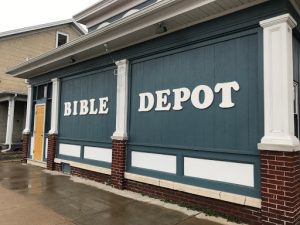
With its vibrant blue exterior, Bible Depot catches the eye of passing visitors and locals alike. Well, the paint job isn’t the most eye-catching aspect of the outside of the store, not when ‘Bible Depot” is sprawled, with large white letters, across the side of the building that faces out onto Front Street. Though, its old yellow façade might have been more intriguing to the eye but more crowded aesthetically. Its doors have been open for going on 88 years, having opened in 1931 originally on Main Street but then moving in the early 1940s to where it is now on Front Street. Sunbury is not a particularly wealthy town, with the median household income averaging around $32,000, according to the Data USA (Data USA). But the amount of businesses on the main road is telling that businesses still thrive in this area.
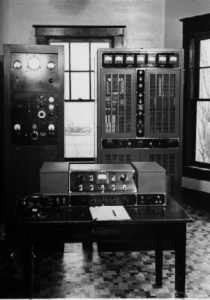
Another large part of Sunbury is the community of churches, there are many Christian churches, as well as other places of worship in the area surrounding the bookstore. This store, everything it has done for the community, all of it, started with little bibles handed out by the Reverend who founded the store. And then, when the WKOK-AM radio station went on the air in 1933, Reverend Ney appeared every week to advertise for the store.
Shortly after Nancy assumed ownership in 1970, pastors from the local churches came into the store and threatened to boycott Bible Depot for carrying a controversial chick tract – a short evangelical gospel tract. Nancy said she spent a lot of time debating about whether to discontinue the chick tract or to continue to sell it and after a lot of praying she decided not to carry the chick tract anymore. The store was never actually boycotted, but this is a particularly outstanding instance of discomfort between the store and the community. But this store has built a strong community, one that has grown through the hardships of area floods and local controversy. This store has become a staple within Sunbury, a true symbol representing the community of which it is a part. Bible Depot tells us a story through its history from its simple beginnings with Reverend Ney handing out Bibles door to door to Nancy’s current ownership of this treasure hunt of a store.
The store controls its own narrative by the way it is set up to appease its customers. This store has become particularly significant as it is not only a store, but a home to its owner. Bible Depot represents an inspiring tale of small business culture through how a tiny, family-run bookstore became what it is today. All the customers who enter the store are welcomed graciously and are considered to be a part of that family. One of the most important things about Bible Depot is how accepting it is of a diversity of religious backgrounds and all walks of life. It is a place that is constantly changing, not necessarily always in terms of its physical appearance, but because of the people that visit and shape the store into the place that it is and the role it plays within the Sunbury community.
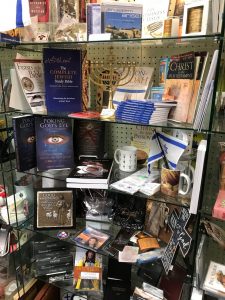
Our experiences visiting Bible Depot gave us a lot of insight into the type of identity and mission the store is trying to project. As you walk through the store, you are fully immersed in a collection that has been carefully curated by Nancy Ney to reflect not only her personal interests, but the interests of everyone in Sunbury and the surrounding community. Tim Cresswell helps us to understand Bible Depot as it is immersed in this community not just as a space, but as a place – a meaningful location defined by its physical location, its local and its sense of place (Cresswell). Using the historical contrasting ideas of place, mentioned by Laura Miller, as reactionary and exclusionary and as open and progressive (constantly contingent and in flux) it seems that somehow, Bible Depot fits both of these descriptors.
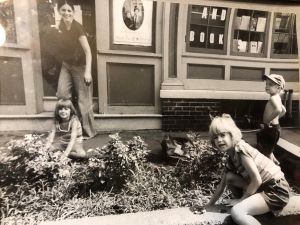
Bible Depot functions as a gathering place – a place for anyone to congregate and commune within a “family” setting. When we look at the world as a world of places we see “attachments and connections between people and place. We see worlds of meaning and experience” (Cresswell 11). Bible Depot is an oasis in which a world of meaning and experience has been created within its walls. Nancy herself told us that Bible Depot is a place full of miracles, a place where people may not necessarily come in to buy things but might just come in to have a seat and have someone to talk to, to comfort them and to give them a coffee. She claims that it’s a people place and that “we’re here to bless others with the blessings God has given to us and when we see a need, we ask God for guidance and we pray for people and try to give them guidance.” This home-like quality of Bible Depot establishes it as not only a store where customers come to purchase things they may need or want, but as an actual “place,” a gathering, a community.
Bible Depot is greatly defined by its history, its owner, and its customers, but the one thing around which all these influences is centered is the collection housed within the store. The diversity and seemingly chaotic nature of the collection is at first a little confusing to visitors to the store. However, the more you examine the way the collection is structured, you begin to see that it is, in fact, a type of organized chaos and that everything has been carefully selected and placed exactly where it is meant to be.
To understand the store’s collection, you first have to appreciate its definition of literature. To do this, you have to have a firm grasp on the concept of self-care. There is a common misconception that self-care is a very individualized process, only applicable or usable by one person for themself. However, the term itself implies some entity taking care of itself; this could be an individual or even a community. In the case of Bible Depot, the definition of literature endorses a narrative of self-care both at the individual and the community level. Because Nancy Ney has created a collection with the interests of her community in mind, her collection acts as self-care for that entire community. We can see this literature of self-care on the individual level through the books in the “main” book room, housing books on divorce, prayer, counseling, etc. Yet on the other side of the store, there is a room we frequently call the “children’s room,” containing anything from posters and board games to Sunday school supplies, activity books, sheet music, stickers, and more. It seems, at first, difficult to fit this room into the store’s literature as defined by self-care. However, this seems to be a room that subscribes more to the idea of community self-care. This room provides customers with ways to better their community either through music, through fellowship and games, or through sharing religion with children. Furthermore, in the front room in which the cash register sits, there are many display cases of jewelry and other trinkets of either something symbolically religious or engraved with a scripture verse. These, too, fit into the narrative of self-care as those who purchase these items are seeking to carry a piece of reassurance and hope with them, close to their hearts wherever they go.
It is true that Bible Depot is filled with many “things,” but these things are more than just mere objects lined up along shelves. In the fifth installment of the Harry Potter series by J.K. Rowling, Harry Potter and the Order of the Phoenix, a group of Hogwarts students, who lovingly call themselves Dumbledore’s Army, come across a room known as the “Room of Requirement.” This room somehow knows what its visitors need and upon entering the room, anything and everything someone needs is readily available within its stone walls. Sometimes more than one person may need the same thing and the room will adapt to those needs. All one has to do to make the room appear is walk past the section of blank wall three times concentrating very deeply on what they need. Bible Depot is, in a way, a Room of Requirement for the Susquehanna Valley community. Because the store provides self-help to both the individual and the community it holds anything and everything someone might neeed and specifically holds the things that people may not even know they need, but should have, whether that’s children or adults. It’s like a scavenger hunt resource room just waiting to be discovered by those who need it.
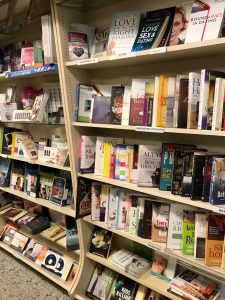
It is very difficult to walk into Bible Depot and not immediately feel imbued with the spirit and attitude with which the store is so heavily infused. While visitors to the store are, yes, surrounded by objects, they are also surrounded by “things.” Bruno Latour tells us that when we have little investment in something we are more likely to view things as mere objects and not as these multidimensional “things.” Though all the objects in the store have a monetary value assigned to them, they also have an inherent spiritual and personal value. Nancy Ney views all the objects in her store as “things” and has ascribed so much meaning and attachment to each thing that this kind of connection is therefore encouraged in every customer who walks through her doors. The contents of the store, as well as the store itself, are not mere tools, but are necessarily things that can provide fulfillment, enrichment, and meaning to our lives.
In Philipp Bloom’s book To Have and to Hold, he explains that “by surrounding ourselves with objects we hope to immerse ourselves in what is represented by them, with what they represent to us who are unwilling to accept that it will always remain elusive and cannot be locked into things” (Bloom 156). Here we see that Bloom has a bit of a different definition of “things” from Latour, one that probably aligns more closely to Latour’s conception of objects. However, Bloom’s idea is still valid. It is often not easy to distill the meaning of objects and therefore we must make the conscious effort to immerse ourselves in what is represented by them. Likewise, we must also examine what these objects represent to us though these representations may sometimes seem elusive and difficult to decipher.
This idea very much reflects our experience getting to know Bible Depot. At first it was exceedingly difficult to understand the meaning or purpose of any of the objects individually and consequently the message of the store and everything it stands for. But to find the answer, one need look no further than the heart of the store itself – the Bible Room. This room is the most important “place” in the store and is also home to the most important ”thing” in the store. The Bible Room is quite literally the heart of the bookstore situated just between Nancy’s home and the store around it. It is representative of the origins of Bible Depot and all the history that has accompanied it, as well as being the store’s namesake. When we consider all the ways in which Bible Depot is a gathering, a collection of “things” and a place in which literature is understood as a self-conscious narrative of self-care and reflection for the individual and the community, we can see that this small blue house on nestled along the Susquehanna River is much more than a store or resource. It is an oasis, a home, an idyllic escape and refuge for all who wish for or require it.
Citations
Text
Benjamin, Walter. “Unpacking My Library.” Illuminations, edited by Hannah Ardent, Schocken Books, pp. 59–67.
Bloom, Philipp. To Have and To Hold. Harry N. Abrams, 2004.
Delaney, Carol. “Spatial Locations.” Investigating Culture, John Wiley & Sons, 2011, pp. 37–67
Latour, Bruno. “Why Has Critique Run Out of Steam? From Matters of Fact to Matters of Concerns.” JSTOR, The University of Chicago Press, May 2004, www.jstor.org/stable/10.1086/421123?seq=1#metadata_info_tab_contents.
Miller, Peter. “The Chronicle Review.” How Objects Speak, 10 Sept. 2014, s3.us-east-1.amazonaws.com/blackboard.learn.xythos.prod/57a9d55a4370f/585932?response-content-disposition=inline; filename*=UTF-8”How Objects Speak – The Chronicle Review – The Chronicle of Higher Education.pdf&response-content-type=application/pdf&X-Amz-Algorithm=AWS4-HMAC-SHA256&X-Amz-Date=20190501T184226Z&X-Amz-SignedHeaders=host&X-Amz-Expires=21600&X-Amz-Credential=AKIAIL7WQYDOOHAZJGWQ/20190501/us-east-1/s3/aws4_request&X-Amz-Signature=7b820ab50c309fb3a0250aac3974fb25cf3902ca4168533d961c5f7e262fe5a4.
Rowling, J.K. Order of the Phoneix. Bloomsbury Publisher, 1997.
Online
Data USA “Employment by Industries” chart. https://datausa.io/profile/geo/sunbury-pa/
“Google Maps.” Google Maps. Google, n.d. Web. 1 May 2019, http://maps.google.com/.
“Time Graphics.” Time Graphic. Time.Grapjic, n.d. Web. 1 May 2019, https://time.graphics/line/234320
“Thinglink,” Thinglink.com. Web. 1 May 2019
Pictures
Bucci, John. Bible Depot, Sunbury, Pennsylvania
Chobanoff, Anna. Bible Depot, 1 May 2019, Sunbury, Pennsylvania
WKOK Radio Station. <http://www.eagle107.com/Eagle_107/107_Station_History.htm>

0 Comments